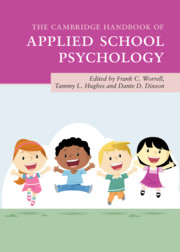Book contents
- The Cambridge Handbook of Applied School Psychology
- The Cambridge Handbook of Applied School Psychology
- Copyright page
- Contents
- Contributors
- Contributor Biographies
- Acknowledgments
- 1 Broadening the Focus of School Psychology Practice
- Part I Individual-Level Academic Interventions
- Part II Teacher- and System-Level Interventions
- 6 School-Based Interventions
- 7 Helping Teachers Use Progress Monitoring Data for Intervention Decisions
- 8 Supporting Teachers in Tier 1 Instruction: Use of Coaching and Formative Assessment
- 9 The Academic Support Index: A Tool for Contextualizing Student Data
- Part III Interventions from Educational and Social/Personality Psychology
- Part IV Behavioral and Social-Emotional Interventions
- Part V Health and Pediatric Interventions
- Part VI Family Connections and Life Transitions
- Part VII Special Populations
- Part VIII Conclusion
- Index
- References
8 - Supporting Teachers in Tier 1 Instruction: Use of Coaching and Formative Assessment
from Part II - Teacher- and System-Level Interventions
Published online by Cambridge University Press: 18 September 2020
- The Cambridge Handbook of Applied School Psychology
- The Cambridge Handbook of Applied School Psychology
- Copyright page
- Contents
- Contributors
- Contributor Biographies
- Acknowledgments
- 1 Broadening the Focus of School Psychology Practice
- Part I Individual-Level Academic Interventions
- Part II Teacher- and System-Level Interventions
- 6 School-Based Interventions
- 7 Helping Teachers Use Progress Monitoring Data for Intervention Decisions
- 8 Supporting Teachers in Tier 1 Instruction: Use of Coaching and Formative Assessment
- 9 The Academic Support Index: A Tool for Contextualizing Student Data
- Part III Interventions from Educational and Social/Personality Psychology
- Part IV Behavioral and Social-Emotional Interventions
- Part V Health and Pediatric Interventions
- Part VI Family Connections and Life Transitions
- Part VII Special Populations
- Part VIII Conclusion
- Index
- References
Summary
Teachers are powerful contributors to students’ success from preschool through 12th grade; much of students’ educational achievement is dependent on the skills they are taught and teachers’ effectiveness in engaging and delivering instruction in the classroom. A positive learning environment is grounded in teachers’ abilities to implement Tier 1 instructional and behavior management practices. School psychologists are uniquely positioned to support teachers in the use of practices that are known to influence student learning and social behavior. In this chapter, we describe the theory and evidence supporting common Tier 1 classroom practices and provide examples of those practices in schools. The use of formative assessment in identifying and promoting instructional and behavior management practices is then discussed. Next, we describe an evidence-based instructional coaching approach that integrates observational data on universal practices for guiding decisions and actions (identify needs, set goals, monitor change) in the coaching process. Finally, we offer recommendations and resources for supporting teacher professional development.
- Type
- Chapter
- Information
- The Cambridge Handbook of Applied School Psychology , pp. 120 - 137Publisher: Cambridge University PressPrint publication year: 2020



